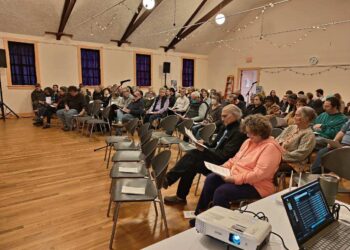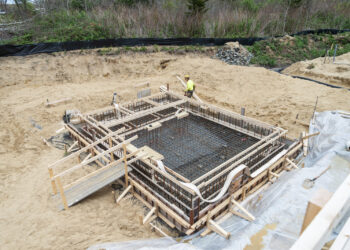On Wednesday, Aug. 21, patients, nurses and domestic staff moved into the new Martha’s Vineyard Hospital, and that institution, or rather the brand new edition of that institution, began to function as its founders have long dreamed it might. For months carpenters, masons, plumbers and painters have been employed on the building which occupies a prominent site beside the road leading from Oak Bluffs to Vineyard Haven, and it is fairly safe to say that never a week has passed, scarcely a day, nut that some stranger, riding along the road, has inquired just where the new hospital might be. Less than a week before it was occupied one such inquiry was made by a person who is fairly familiar with the Island.
At first thought this seems strange. The hospital is not a small building. It contains many rooms, wards, etc., and it is of the height of ordinary two story buildings. Standing, as it does, on an elevation, one would naturally suppose that it would attract instant attention. And it does attract attention, but the secret is this, no one suspects that it is a hospital.
It does not resemble in any way the ordinary hospital, or in fact, any other type of public institution. Rather it appears like the summer home of a wealthy family whose taste runs to the colonial type of architecture.
There is the shingled exterior, left to weather naturally; the plain woodwork; the colonial main entrance, with its rough stone steps; the long, low roof, with its gentle slope and overhanging eaves belong with the rest; and the solariums on south and east are not recognizable as such from any view from the roads. Truly, the building blends with its surroundings and conforms to the general type of Island architecture.
Like Private Residence
Naturally, to enter the hospital means to discover its identity, and yet, if it were possible to conduct a blindfolded person into some of the rooms, he would never guess that he was not in a luxurious private residence. The colonial touch and general atmosphere predominate inside as well as out, and particularly in the hall and reception room.
The hospital is divided by wide corridors running in the form of a cross, with the lower end the shortest and terminating in the main entrance. On entering, therefore, one can see far ahead to the door opening on the eastern porch. Here, beneath the high dome, lighted by a hanging lantern by night and the sunshine through the glass roof by day, is a lobby, panelled in colonial style, with the woodwork, of African mahogany, filled, but otherwise left natural. Painted walls and linoleum covered floors give a neat, clean appearance, and the colonial style furniture, desk and chairs, bear no resemblance to ordinary hospital equipment.
Turning to the left, the reception room is entered. This room contains more panelling, and is fully furnished with more colonial furniture, the gift of Miss Amy Ferris, who furnished the room in memory of her parents. It is a cozy, homelike room, where visitors may sit, or consult an attending physician, either through the wicket window, or by entering the doctors’ office which is adjoining.
Next in line, and accessible from either the doctors’ office or the corridor, is the superintendent’s room. This is furnished in mahogany. A large day-bed supplies a resting place for the busy superintendent, by day or night.
Instruments Are Memorial Gift
Leaving the superintendent’s room, the etherizing room is next on the same side of the corridor, with the doctors’ lavatory adjoining, and at the end of the corridor, occupying the entire width, is the operating room, bright with sunshine, for the roof is of glass, and fitted so that it can be illuminated to the same degree by artificial lights. Great cases of instruments line the walls, the gift of Paul Runyun, son of the famous surgeon, Dr. Mefford Runyon, long an Edgartown summer resident, who formerly owned them. It is said that this collection of instruments is worth in excess of $10,000.
On the opposite side of the operating room from the doctors’ lavatory is the sterilizing room, where every conceivable instrument and apparatus is installed with which to combat bacteria. This is the first room on the other side of the corridor, and is next to the delivery room as well.
Glass, white enamel and polished nickel, all spotless, clean and plain, is the order in these rooms, but immediately after the delivery room is passed, is the baby ward, where the tiny blue and pink cribs are waiting for future Vineyarders. Only one was occupied on the first day of the occupation. That was the dark-haired little son of Mr. and Mrs. Samuel Norton of Edgartown, peacefully sleeping beneath a pink-trimmed blanket and unmindful of the visitors who came and went.
A completely fitted X-ray room lies next, the gift of Mrs. Edward P. Worth in memory of her husband, and then the patients’ entrance, for no patients are to be brought in at the main entrance.
This entrance opens from a very large recessed veranda, and there are two doors. One opens opposite the doctor’s office, while the other opens into the emergency rooms, which is almost as complete as many operating rooms used to be. A large lavatory adjoins it. The description thus far completes the corridor to the left of the main entrance, and brings the visitor to the lobby where the corridors cross.
Kitchens Are Odor-Proof
Following the corridor straight ahead from the main entrance, the diet kitchen is located first on the left. It is a daintily arranged little room equipped with electric refrigerator and other modern touches, an ample supply of dishes and much storage space. The kitchen is next, a big pleasant room, finished with buff walls and green trimmings. There, too, is a large electric ice machine, slate sinks, and many other appliances. The entrance for tradesmen is at this point. These rooms are odor proof, and to make it doubly sure, the doors are all double, with several feet of space between them.
The pantry lies next to the kitchen and between that and the nurses dining room. This last is a wonderfully pleasant room. This last is a wonderfully pleasant room. Walls are covered with wallpaper in the well known whaling design; the window draperies are of chintz, and the furniture is of the same oldfashioned style, harmonizing with the panelled walls.
On the same side of the corridor are more lavatories, single rooms, semi-private rooms and the four-bed wards, arranged to be divided by curtains, but each of them is decorated a little differently from the rest. White and grey, white and blue, or green, the metal beds and other furnishings are painted and grained to resemble wood, and all carry out the colonial effect,
Men’s and women’s wards are both so decorated and furnished and there is the same note of comfort and luxury in the four-bed wards as there is in the private rooms, although the latter have more furniture, and private toilets, while a single bathtub is so arranged that patients from two rooms may use it. There is the children’s ward, given by the J. Herbert Ware family, and containing the tiny cribs and cots, all decorated in bright colors to delight the eyes of little convalescents. Pharmacy and utility rooms follow, and there is a big supply room at the end of the row.
At the right of the main entrance is the private room de luxe. It is a big, oldfashioned room, as are all the rest, but this is panelled to the ceiling, contains a large fireplace with British grenadier andirons, and a tall, old clock with wooden works, stands on the mantel. The bedstead is finished in maple, and it resembles the guest room in some old manor house.
At the end of the main and righthand corridors, are the sun porches, ample in size and each with charming views of water and green trees. An elaborate system of light signals allow nurse to keep track of patients in her charge as she moves about, for the lights show over the doors of the rooms and on a signal board near the main entrance.
The one thing that must impress the visitor more than anything else is the way the building is arranged so that the sun must always shine in. At every hour of the day, the sun’s rays can reach every room occupied by patients unless the doors are closed or windows are covered. Perhaps the next most impressive feature is the series of views that is presented from windows and porches of the hospital. Looking in every direction one may see blue water, trees, sky and, at this season of the year, green grass and foliage.
There is a fine heating system installed, storage space enough in basement and attic so that the remainder of the hospital will never be cluttered, and in every part of the place it is plainly to be seen that someone has thought and planned and worked to make this place as cheerful as possible and to banish all thought of pain or illness.
No one wants to be ill, or to become an inmate of a hospital, but most Vineyard folks will agree that if it must be, then our own Island offers accommodations that are most difficult to surpass, at the new Martha’s Vineyard Hospital.








